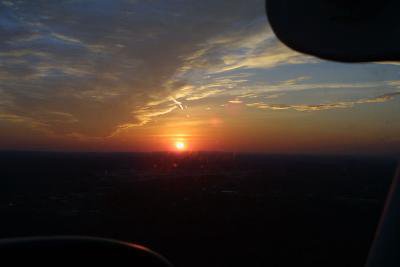The long-awaited trip
I lost count of how many attempts we made for this particular flight, but after weather and mechanical delays (a broken starter on the left engine) it finally happened: a 5.8 hour cross-country wrapping up requirements for both the instrument and commercial ratings.
The first part of it would consist of an IFR flight with landings at three airports using three different types of approaches and the second was a VFR 300nm night trip required for the commercial rating.
We took off from Manassas around 1600 local and headed to Charlottesville, VA to shoot the ILS3. As the controller gave me a final vector to intercept the localizer, Ron pulled the left engine. This happened at the precise moment ATC called back to clear us for the approach. I made sure we were at blue line or better (blue line provides the best rate of climb on both one or two engines in the Seminole) and at or above the minimum altitude for that portion of the approach. I then called the controller back to acknowledge his instructions and went through the emergency checklist before calling tower to inform them we were inbound on the ILS.
A lot going on at once!
The approach itself was little trouble and we soon went missed and were on our way to Lynchburg, VA for the second part of the IFR flight. It was a real shame to have been stuck wearing those wretched foggles because the scenery in that area is beautiful. Ron graciously allowed me to take a quick peak, which revealed chains of mountains below us. Stunning.
As we neared Lynchburg for the VOR4, it appeared that our vacuum system stopped functioning (for practice purposes of course, otherwise this would've been a bad day, especially after that earlier "engine failure") and I was therefore faced with the task of shooting this unfamiliar approach using partial panel techniques that we had not yet practiced since our sim only has an HSI, which is typically failed for this exercise.
I flew to the LYH VOR for the procedure turn and fell a little behind because I fixated on the VOR and ended up paying little attention to the magnetic compass. But within a few seconds I was back on track and my eyes went from one to the other, stopping on the way on the turn coordinator, altimeter, airspeed indicator and the clock. The instrument scan on such a partial panel approach has to be lightening fast and it'll take me a little more practice to get up to speed with it, but the approach went reasonably well. The mind also has to be a step ahead, making calculations for timed turns, factoring in wind correction and anticipating the next portion of the approach as well as flying the current one.
After going missed at Lynchburg, we headed southeast to Wilmington, NC. Favorable winds gave us good groundspeeds, clocking in as high as 200kts at one point. This part of the flight was the longest and turned out to be quite uneventful and pleasant. Along the way we spoke to a few controllers, many of whom were very friendly and kindly accomodated our request to divert from the original flight plan and fly direct to Wilmington.
A few miles out I looked out to our right to see a fiery red sun slowly recede behind a hazy horizon. It almost seemed to be melting away as the perfectly round bright red sphere slowly turned oval in its own golden fluid before vanishing for the day.
Back under the hood I set up for the GPS35 and flew a tidy approach to a nice night landing.
We parked the plane and headed a couple of miles from the airport for BBQ.
A couple of hours later, we were back in the air fighting stiff headwinds on our long way home. The flight, nonethless, was very enjoyable and smooth. I've said it before, but night flying is amazing. It's quite striking what a few lights can do to spruce up things such as commercial complexes, which during the day are quite ugly.
Near Richmond we heard an American Eagle flight talking to ATC. Its callsign was followed by "Lifeguard." Ron explained to me that if an aircraft is carrying a passenger who suddenly becomes ill, they will tag that on the end of the callsign.
Since Manassas tower was closed when we arrived for the GPS34R approach, I got click the runway lights from the cockpit, which is always a really cool thing to do! Small things, huh?
More flying tomorrow morning: partial panel VORs, perhaps a GPS approach thrown in and then home to Boston for the night to see my wife. Come to think of it, this is the true long-awaited trip...



0 Comments:
Post a Comment
<< Home